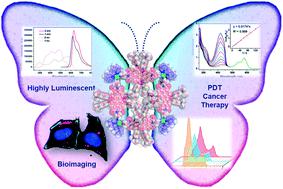当前位置:
X-MOL 学术
›
Chem. Sci.
›
论文详情
Our official English website, www.x-mol.net, welcomes your
feedback! (Note: you will need to create a separate account there.)
Designing a highly stable coordination-driven metallacycle for imaging-guided photodynamic cancer theranostics
Chemical Science ( IF 7.6 ) Pub Date : 2020-06-30 , DOI: 10.1039/d0sc02236e Lizhen He 1, 2, 3, 4 , Li-Xuan Cai 4, 5, 6, 7, 8 , Meng-Hua Li 4, 9, 10, 11 , Guang-Lu Zhang 4, 5, 6, 7, 8 , Li-Peng Zhou 4, 5, 6, 7, 8 , Tianfeng Chen 1, 2, 3, 4 , Mei-Jin Lin 4, 9, 10, 11 , Qing-Fu Sun 4, 5, 6, 7, 8
Chemical Science ( IF 7.6 ) Pub Date : 2020-06-30 , DOI: 10.1039/d0sc02236e Lizhen He 1, 2, 3, 4 , Li-Xuan Cai 4, 5, 6, 7, 8 , Meng-Hua Li 4, 9, 10, 11 , Guang-Lu Zhang 4, 5, 6, 7, 8 , Li-Peng Zhou 4, 5, 6, 7, 8 , Tianfeng Chen 1, 2, 3, 4 , Mei-Jin Lin 4, 9, 10, 11 , Qing-Fu Sun 4, 5, 6, 7, 8
Affiliation

|
Coordination-driven self-assembly features good predictability and directionality in the construction of discrete metallacycles and metallacages with well-defined sizes and shapes, but their medicinal application has been limited by their low stability and solubility. Herein, we have designed and synthesized a highly stable coordination-driven metallacycle with desired functionality derived from a perylene-diimide ligand via a spontaneous deprotonation self-assembly process. Brilliant chemical stability and singlet oxygen production ability of this emissive octanuclear organopalladium macrocycle make it a good candidate toward biological studies. After cellular uptake by endocytosis, the metallacycle exhibits potent fluorescence cell imaging properties and cancer photodynamic therapeutic ability through enhancing ROS production, with high biocompatibility and safety. This study not only provides a rational design strategy for highly stable luminescent organopalladium metallacycles, but also sheds light on their application in imaging-guided photodynamic cancer therapy.
中文翻译:

设计用于成像引导的光动力学癌症治疗的高度稳定的配位驱动金属环
协调驱动的自组装在具有明确定义的尺寸和形状的离散金属环和金属笼的构造中具有良好的可预测性和方向性,但其低稳定性和溶解性限制了其在医学上的应用。在这里,我们设计并合成了一种高稳定的配位驱动的金属环,具有所需的功能,该功能是通过via-二酰亚胺配体通过自发的去质子化自组装过程。这种发光的八核有机钯大环化合物具有出色的化学稳定性和单线态氧产生能力,使其成为生物学研究的良好候选者。通过内吞作用吸收细胞后,金属环通过增强ROS的产生,显示出强大的荧光细胞成像特性和癌症光动力治疗能力,具有高度的生物相容性和安全性。这项研究不仅为高度稳定的发光有机钯金属杂环化合物提供了合理的设计策略,而且还阐明了它们在成像引导的光动力癌症治疗中的应用。
更新日期:2020-08-05
中文翻译:

设计用于成像引导的光动力学癌症治疗的高度稳定的配位驱动金属环
协调驱动的自组装在具有明确定义的尺寸和形状的离散金属环和金属笼的构造中具有良好的可预测性和方向性,但其低稳定性和溶解性限制了其在医学上的应用。在这里,我们设计并合成了一种高稳定的配位驱动的金属环,具有所需的功能,该功能是通过via-二酰亚胺配体通过自发的去质子化自组装过程。这种发光的八核有机钯大环化合物具有出色的化学稳定性和单线态氧产生能力,使其成为生物学研究的良好候选者。通过内吞作用吸收细胞后,金属环通过增强ROS的产生,显示出强大的荧光细胞成像特性和癌症光动力治疗能力,具有高度的生物相容性和安全性。这项研究不仅为高度稳定的发光有机钯金属杂环化合物提供了合理的设计策略,而且还阐明了它们在成像引导的光动力癌症治疗中的应用。











































 京公网安备 11010802027423号
京公网安备 11010802027423号